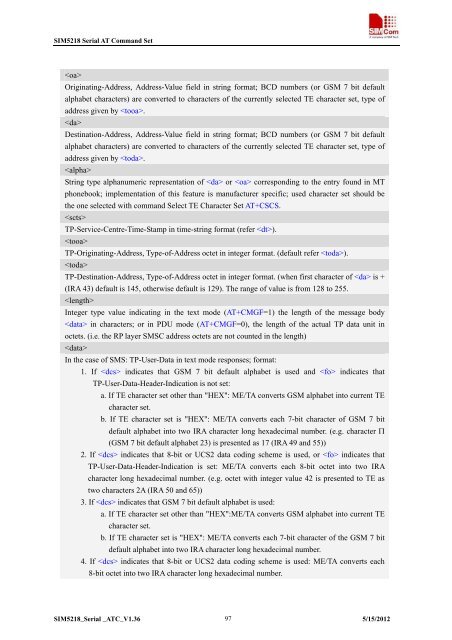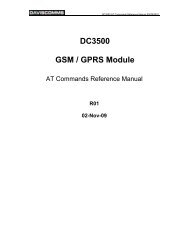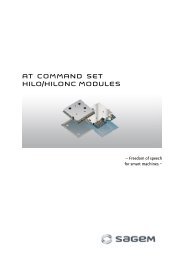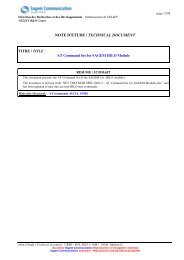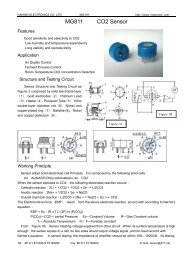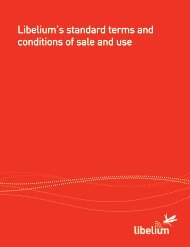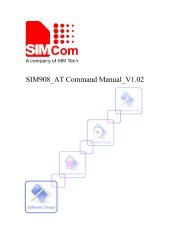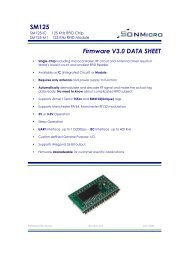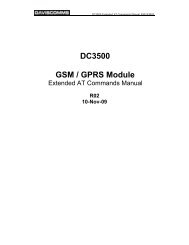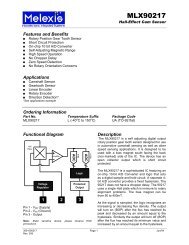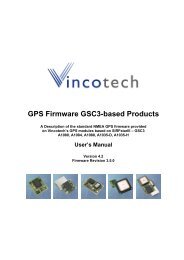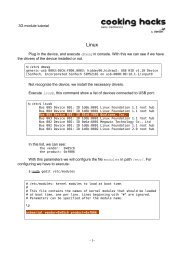- Page 1 and 2:
AT Command Set SIM5218_Serial_ATC_V
- Page 3 and 4:
SIM5218 Serial AT Command Set Versi
- Page 5 and 6:
SIM5218 Serial AT Command Set 5.9 A
- Page 7 and 8:
SIM5218 Serial AT Command Set 21.3.
- Page 9 and 10:
SIM5218 Serial AT Command Set V1.18
- Page 11 and 12:
SIM5218 Serial AT Command Set V1.24
- Page 13 and 14:
SIM5218 Serial AT Command Set 12.31
- Page 15 and 16:
SIM5218 Serial AT Command Set 19.13
- Page 17 and 18:
SIM5218 Serial AT Command Set Conte
- Page 19 and 20:
SIM5218 Serial AT Command Set 6.16
- Page 21 and 22:
SIM5218 Serial AT Command Set 10.3
- Page 23 and 24:
SIM5218 Serial AT Command Set 16.3
- Page 25 and 26:
SIM5218 Serial AT Command Set 21.1.
- Page 27 and 28:
SIM5218 Serial AT Command Set 22.21
- Page 29 and 30:
1 Introduction 1.1 Scope The presen
- Page 31 and 32:
SIM5218 Serial AT Command Set […
- Page 33 and 34:
SIM5218 Serial AT Command Set Test
- Page 35 and 36:
SIM5218 Serial AT Command Set Examp
- Page 37 and 38:
SIM5218 Serial AT Command Set Defin
- Page 39 and 40:
SIM5218 Serial AT Command Set 3.7 A
- Page 41 and 42:
SIM5218 Serial AT Command Set 2 - u
- Page 43 and 44:
SIM5218 Serial AT Command Set 4 Cal
- Page 45 and 46:
SIM5218 Serial AT Command Set AT+CM
- Page 47 and 48: SIM5218 Serial AT Command Set The t
- Page 49 and 50: SIM5218 Serial AT Command Set VOICE
- Page 51 and 52: SIM5218 Serial AT Command Set Execu
- Page 53 and 54: SIM5218 Serial AT Command Set 4.13
- Page 55 and 56: SIM5218 Serial AT Command Set Read
- Page 57 and 58: SIM5218 Serial AT Command Set +CR:0
- Page 59 and 60: SIM5218 Serial AT Command Set AT+CR
- Page 61 and 62: SIM5218 Serial AT Command Set +CLVL
- Page 63 and 64: SIM5218 Serial AT Command Set The c
- Page 65 and 66: SIM5218 Serial AT Command Set SIM P
- Page 67 and 68: SIM5218 Serial AT Command Set Defin
- Page 69 and 70: SIM5218 Serial AT Command Set 4 - D
- Page 71 and 72: SIM5218 Serial AT Command Set +CPCM
- Page 73 and 74: SIM5218 Serial AT Command Set This
- Page 75 and 76: SIM5218 Serial AT Command Set 4.34
- Page 77 and 78: SIM5218 Serial AT Command Set 5 Vid
- Page 79 and 80: SIM5218 Serial AT Command Set Video
- Page 81 and 82: SIM5218 Serial AT Command Set OK AT
- Page 83 and 84: SIM5218 Serial AT Command Set 5.8 A
- Page 85 and 86: SIM5218 Serial AT Command Set 6 SMS
- Page 87 and 88: SIM5218 Serial AT Command Set Mobi
- Page 89 and 90: SIM5218 Serial AT Command Set 6.4 A
- Page 91 and 92: SIM5218 Serial AT Command Set The t
- Page 93 and 94: SIM5218 Serial AT Command Set 6.8 A
- Page 95 and 96: SIM5218 Serial AT Command Set Defin
- Page 97: SIM5218 Serial AT Command Set t>[ +
- Page 101 and 102: SIM5218 Serial AT Command Set OK If
- Page 103 and 104: SIM5218 Serial AT Command Set (IRA
- Page 105 and 106: SIM5218 Serial AT Command Set TP-De
- Page 107 and 108: SIM5218 Serial AT Command Set ooa>/
- Page 109 and 110: SIM5218 Serial AT Command Set Examp
- Page 111 and 112: SIM5218 Serial AT Command Set OK If
- Page 113 and 114: SIM5218 Serial AT Command Set 6.20
- Page 115 and 116: SIM5218 Serial AT Command Set Desti
- Page 117 and 118: SIM5218 Serial AT Command Set If te
- Page 119 and 120: 7 Camera Related Commands 7.1 AT+CC
- Page 121 and 122: SIM5218 Serial AT Command Set SXGA
- Page 123 and 124: SIM5218 Serial AT Command Set Write
- Page 125 and 126: SIM5218 Serial AT Command Set The c
- Page 127 and 128: SIM5218 Serial AT Command Set Synta
- Page 129 and 130: SIM5218 Serial AT Command Set CAMER
- Page 131 and 132: SIM5218 Serial AT Command Set ERROR
- Page 133 and 134: SIM5218 Serial AT Command Set +CCAM
- Page 135 and 136: SIM5218 Serial AT Command Set 8 Aud
- Page 137 and 138: SIM5218 Serial AT Command Set AT+CQ
- Page 139 and 140: SIM5218 Serial AT Command Set Defin
- Page 141 and 142: SIM5218 Serial AT Command Set OK 8.
- Page 143 and 144: SIM5218 Serial AT Command Set 8.11
- Page 145 and 146: SIM5218 Serial AT Command Set 8.13
- Page 147 and 148: SIM5218 Serial AT Command Set 9 Net
- Page 149 and 150:
SIM5218 Serial AT Command Set Test
- Page 151 and 152:
SIM5218 Serial AT Command Set "PF"
- Page 153 and 154:
SIM5218 Serial AT Command Set Integ
- Page 155 and 156:
SIM5218 Serial AT Command Set The c
- Page 157 and 158:
SIM5218 Serial AT Command Set Param
- Page 159 and 160:
SIM5218 Serial AT Command Set s>[,[
- Page 161 and 162:
SIM5218 Serial AT Command Set +CME
- Page 163 and 164:
SIM5218 Serial AT Command Set 3 - A
- Page 165 and 166:
SIM5218 Serial AT Command Set AT+CA
- Page 167 and 168:
SIM5218 Serial AT Command Set 3 - c
- Page 169 and 170:
SIM5218 Serial AT Command Set 0 - c
- Page 171 and 172:
SIM5218 Serial AT Command Set +CPOL
- Page 173 and 174:
SIM5218 Serial AT Command Set YES V
- Page 175 and 176:
SIM5218 Serial AT Command Set SIM P
- Page 177 and 178:
SIM5218 Serial AT Command Set Freq
- Page 179 and 180:
SIM5218 Serial AT Command Set Test
- Page 181 and 182:
SIM5218 Serial AT Command Set NOTE
- Page 183 and 184:
SIM5218 Serial AT Command Set AT+CC
- Page 185 and 186:
SIM5218 Serial AT Command Set sub q
- Page 187 and 188:
SIM5218 Serial AT Command Set 9.30
- Page 189 and 190:
SIM5218 Serial AT Command Set NO Ve
- Page 191 and 192:
SIM5218 Serial AT Command Set OK AT
- Page 193 and 194:
SIM5218 Serial AT Command Set CELL_
- Page 195 and 196:
SIM5218 Serial AT Command Set mobil
- Page 197 and 198:
SIM5218 Serial AT Command Set mobil
- Page 199 and 200:
SIM5218 Serial AT Command Set - CEL
- Page 201 and 202:
SIM5218 Serial AT Command Set The
- Page 203 and 204:
SIM5218 Serial AT Command Set 10 Mo
- Page 205 and 206:
SIM5218 Serial AT Command Set “CM
- Page 207 and 208:
SIM5218 Serial AT Command Set Examp
- Page 209 and 210:
SIM5218 Serial AT Command Set 1 - f
- Page 211 and 212:
SIM5218 Serial AT Command Set ERROR
- Page 213 and 214:
SIM5218 Serial AT Command Set AT+CA
- Page 215 and 216:
SIM5218 Serial AT Command Set ERROR
- Page 217 and 218:
SIM5218 Serial AT Command Set 10.13
- Page 219 and 220:
SIM5218 Serial AT Command Set The
- Page 221 and 222:
SIM5218 Serial AT Command Set +CSIM
- Page 223 and 224:
SIM5218 Serial AT Command Set Index
- Page 225 and 226:
SIM5218 Serial AT Command Set Pres
- Page 227 and 228:
SIM5218 Serial AT Command Set 10.21
- Page 229 and 230:
SIM5218 Serial AT Command Set 11 SI
- Page 231 and 232:
SIM5218 Serial AT Command Set By us
- Page 233 and 234:
SIM5218 Serial AT Command Set 0x6F5
- Page 235 and 236:
SIM5218 Serial AT Command Set Infor
- Page 237 and 238:
SIM5218 Serial AT Command Set 11.6
- Page 239 and 240:
SIM5218 Serial AT Command Set Write
- Page 241 and 242:
SIM5218 Serial AT Command Set AT+CT
- Page 243 and 244:
SIM5218 Serial AT Command Set AT+CV
- Page 245 and 246:
SIM5218 Serial AT Command Set Test
- Page 247 and 248:
SIM5218 Serial AT Command Set NOTE
- Page 249 and 250:
SIM5218 Serial AT Command Set Synta
- Page 251 and 252:
SIM5218 Serial AT Command Set Write
- Page 253 and 254:
SIM5218 Serial AT Command Set Test
- Page 255 and 256:
SIM5218 Serial AT Command Set 12.22
- Page 257 and 258:
SIM5218 Serial AT Command Set ERROR
- Page 259 and 260:
SIM5218 Serial AT Command Set The i
- Page 261 and 262:
SIM5218 Serial AT Command Set SIM P
- Page 263 and 264:
SIM5218 Serial AT Command Set OK Wr
- Page 265 and 266:
SIM5218 Serial AT Command Set Defin
- Page 267 and 268:
SIM5218 Serial AT Command Set 13 Ph
- Page 269 and 270:
SIM5218 Serial AT Command Set Capac
- Page 271 and 272:
SIM5218 Serial AT Command Set OK 13
- Page 273 and 274:
SIM5218 Serial AT Command Set 145 -
- Page 275 and 276:
SIM5218 Serial AT Command Set 14 Fi
- Page 277 and 278:
SIM5218 Serial AT Command Set AT+FS
- Page 279 and 280:
SIM5218 Serial AT Command Set ] [+F
- Page 281 and 282:
SIM5218 Serial AT Command Set Test
- Page 283 and 284:
SIM5218 Serial AT Command Set Execu
- Page 285 and 286:
SIM5218 Serial AT Command Set AT+FS
- Page 287 and 288:
SIM5218 Serial AT Command Set +FSCO
- Page 289 and 290:
SIM5218 Serial AT Command Set set c
- Page 291 and 292:
SIM5218 Serial AT Command Set ERROR
- Page 293 and 294:
SIM5218 Serial AT Command Set +IPR:
- Page 295 and 296:
SIM5218 Serial AT Command Set AT+IC
- Page 297 and 298:
SIM5218 Serial AT Command Set NO V.
- Page 299 and 300:
SIM5218 Serial AT Command Set Execu
- Page 301 and 302:
SIM5218 Serial AT Command Set AT+CG
- Page 303 and 304:
SIM5218 Serial AT Command Set 17 GP
- Page 305 and 306:
SIM5218 Serial AT Command Set AT+CG
- Page 307 and 308:
SIM5218 Serial AT Command Set Examp
- Page 309 and 310:
SIM5218 Serial AT Command Set Synta
- Page 311 and 312:
SIM5218 Serial AT Command Set uracy
- Page 313 and 314:
SIM5218 Serial AT Command Set +CASS
- Page 315 and 316:
SIM5218 Serial AT Command Set 18 Co
- Page 317 and 318:
SIM5218 Serial AT Command Set 18.2
- Page 319 and 320:
SIM5218 Serial AT Command Set This
- Page 321 and 322:
SIM5218 Serial AT Command Set strin
- Page 323 and 324:
SIM5218 Serial AT Command Set 1 - h
- Page 325 and 326:
SIM5218 Serial AT Command Set AT+CG
- Page 327 and 328:
SIM5218 Serial AT Command Set This
- Page 329 and 330:
SIM5218 Serial AT Command Set Test
- Page 331 and 332:
SIM5218 Serial AT Command Set 13 -
- Page 333 and 334:
SIM5218 Serial AT Command Set conte
- Page 335 and 336:
SIM5218 Serial AT Command Set 1000
- Page 337 and 338:
SIM5218 Serial AT Command Set OK Wr
- Page 339 and 340:
SIM5218 Serial AT Command Set Execu
- Page 341 and 342:
SIM5218 Serial AT Command Set YES 3
- Page 343 and 344:
SIM5218 Serial AT Command Set AT+CG
- Page 345 and 346:
SIM5218 Serial AT Command Set 18.16
- Page 347 and 348:
SIM5218 Serial AT Command Set 19 TC
- Page 349 and 350:
SIM5218 Serial AT Command Set The c
- Page 351 and 352:
SIM5218 Serial AT Command Set Param
- Page 353 and 354:
SIM5218 Serial AT Command Set 0 - n
- Page 355 and 356:
SIM5218 Serial AT Command Set DL>s)
- Page 357 and 358:
SIM5218 Serial AT Command Set This
- Page 359 and 360:
SIM5218 Serial AT Command Set numbe
- Page 361 and 362:
SIM5218 Serial AT Command Set 5 - 2
- Page 363 and 364:
SIM5218 Serial AT Command Set AT+CG
- Page 365 and 366:
SIM5218 Serial AT Command Set AT+ C
- Page 367 and 368:
SIM5218 Serial AT Command Set 19.9
- Page 369 and 370:
SIM5218 Serial AT Command Set Conne
- Page 371 and 372:
SIM5218 Serial AT Command Set Synta
- Page 373 and 374:
SIM5218 Serial AT Command Set AT+SE
- Page 375 and 376:
SIM5218 Serial AT Command Set Examp
- Page 377 and 378:
SIM5218 Serial AT Command Set Execu
- Page 379 and 380:
SIM5218 Serial AT Command Set [][,[
- Page 381 and 382:
SIM5218 Serial AT Command Set Suppo
- Page 383 and 384:
SIM5218 Serial AT Command Set a nu
- Page 385 and 386:
SIM5218 Serial AT Command Set 19.24
- Page 387 and 388:
SIM5218 Serial AT Command Set AT+CD
- Page 389 and 390:
SIM5218 Serial AT Command Set +CIPS
- Page 391 and 392:
SIM5218 Serial AT Command Set 19.30
- Page 393 and 394:
SIM5218 Serial AT Command Set +CPIN
- Page 395 and 396:
SIM5218 Serial AT Command Set ERRO
- Page 397 and 398:
SIM5218 Serial AT Command Set +IP E
- Page 399 and 400:
SIM5218 Serial AT Command Set 20 SI
- Page 401 and 402:
SIM5218 Serial AT Command Set If =2
- Page 403 and 404:
SIM5218 Serial AT Command Set +STGI
- Page 405 and 406:
SIM5218 Serial AT Command Set 0 - D
- Page 407 and 408:
SIM5218 Serial AT Command Set Write
- Page 409 and 410:
SIM5218 Serial AT Command Set 21.1.
- Page 411 and 412:
SIM5218 Serial AT Command Set AT+SM
- Page 413 and 414:
SIM5218 Serial AT Command Set YES V
- Page 415 and 416:
SIM5218 Serial AT Command Set OK 21
- Page 417 and 418:
SIM5218 Serial AT Command Set AT+SM
- Page 419 and 420:
SIM5218 Serial AT Command Set OK Ex
- Page 421 and 422:
SIM5218 Serial AT Command Set AT+PO
- Page 423 and 424:
SIM5218 Serial AT Command Set Subje
- Page 425 and 426:
SIM5218 Serial AT Command Set delet
- Page 427 and 428:
SIM5218 Serial AT Command Set Examp
- Page 429 and 430:
SIM5218 Serial AT Command Set The c
- Page 431 and 432:
SIM5218 Serial AT Command Set Read
- Page 433 and 434:
SIM5218 Serial AT Command Set The u
- Page 435 and 436:
SIM5218 Serial AT Command Set Write
- Page 437 and 438:
SIM5218 Serial AT Command Set The
- Page 439 and 440:
SIM5218 Serial AT Command Set Write
- Page 441 and 442:
SIM5218 Serial AT Command Set +CHTT
- Page 443 and 444:
SIM5218 Serial AT Command Set 225 M
- Page 445 and 446:
SIM5218 Serial AT Command Set Examp
- Page 447 and 448:
SIM5218 Serial AT Command Set ERROR
- Page 449 and 450:
SIM5218 Serial AT Command Set Execu
- Page 451 and 452:
SIM5218 Serial AT Command Set AT+CF
- Page 453 and 454:
SIM5218 Serial AT Command Set shoul
- Page 455 and 456:
SIM5218 Serial AT Command Set … +
- Page 457 and 458:
SIM5218 Serial AT Command Set OK
- Page 459 and 460:
SIM5218 Serial AT Command Set “
- Page 461 and 462:
SIM5218 Serial AT Command Set Examp
- Page 463 and 464:
SIM5218 Serial AT Command Set Read
- Page 465 and 466:
SIM5218 Serial AT Command Set 3 Wro
- Page 467 and 468:
SIM5218 Serial AT Command Set OK 22
- Page 469 and 470:
SIM5218 Serial AT Command Set Wheth
- Page 471 and 472:
SIM5218 Serial AT Command Set Write
- Page 473 and 474:
SIM5218 Serial AT Command Set The
- Page 475 and 476:
SIM5218 Serial AT Command Set Write
- Page 477 and 478:
SIM5218 Serial AT Command Set Write
- Page 479 and 480:
SIM5218 Serial AT Command Set Defin
- Page 481 and 482:
SIM5218 Serial AT Command Set Examp
- Page 483 and 484:
SIM5218 Serial AT Command Set 30 -
- Page 485 and 486:
SIM5218 Serial AT Command Set The
- Page 487 and 488:
SIM5218 Serial AT Command Set Write
- Page 489 and 490:
SIM5218 Serial AT Command Set The c
- Page 491 and 492:
SIM5218 Serial AT Command Set Test
- Page 493 and 494:
SIM5218 Serial AT Command Set 177 I
- Page 495 and 496:
SIM5218 Serial AT Command Set 23.2
- Page 497 and 498:
SIM5218 Serial AT Command Set SIM P
- Page 499 and 500:
SIM5218 Serial AT Command Set AT+PR
- Page 501 and 502:
SIM5218 Serial AT Command Set Count
- Page 503 and 504:
SIM5218 Serial AT Command Set 27 Re
- Page 505 and 506:
SIM5218 Serial AT Command Set 81 In
- Page 507 and 508:
SIM5218 Serial AT Command Set 26 In
- Page 509 and 510:
SIM5218 Serial AT Command Set OK 28
- Page 511 and 512:
SIM5218 Serial AT Command Set 28.2.
- Page 513 and 514:
SIM5218 Serial AT Command Set AT+CC
- Page 515 and 516:
SIM5218 Serial AT Command Set being
- Page 517 and 518:
SIM5218 Serial AT Command Set thing
- Page 519 and 520:
SIM5218 Serial AT Command Set Then
- Page 521 and 522:
SIM5218 Serial AT Command Set 28.7.
- Page 523 and 524:
SIM5218 Serial AT Command Set After
- Page 525 and 526:
SIM5218 Serial AT Command Set AT+CM


